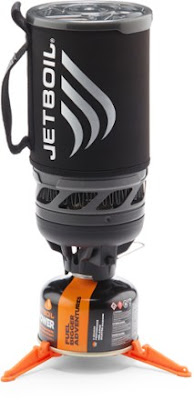To be able to have hot food and drink you need to have a cooker. There are lots of choices out there, but the important features to look for are reliability and ease of lighting, time of the burn and top temperature reached in the case of solid fuel, and weight of the cooker and fuel.
Esbit Cooker
I started out with a Hexamine cooker, since I had one on hand I could easily throw into my kit, but decided to open things up for a re-examination of the Hexi cooker, putting it into a test with three other cookers, the Esbit, the Fire Dragon, and the JetBoil. The first three are solid fuel options, with the last using a fuel canister.
So, let's begin with weight:
Weight of Cooker Weight of Single Fuel Tablet
Esbit 85g / 3oz 10g / 3/8oz
Hexamine 134g / 4 3/4oz 26g / 7/8oz
Fire Dragon 113g / 4oz 26g / 7/8oz
JetBoil 355g / 12 1/2oz 198g / 7oz
(NOTE - The JetBoil cooker weight includes a cooking pot, which the other cookers do not include. The fuel for the JetBoil was a 100g/3.53oz fuel canister which will boil 12 litres of water, the equivalent of at least 24 fuel tablets of the other three stoves.)
Hexamine Cooker
On part one, lighting, the Fire Dragon and JetBoil both started immediately. The Hexi was an old tablet from military surplus and took some time to light. The Esbit, which smelled strongly of fish before lighting (that smell did not continue during the burn) was in a sealed packet in a recent purchase and also took some time to light.
For cook time the stoves gave the following results with 500ml of water in each case:
Time of Burn Maximum Temperature Reached
Esbit 14 min 15 sec 178 Fahrenheit
Hexamine 8 min 186.8 Fahrenheit
Fire Dragon 10 min 50 sec 191 Fahrenheit
JetBoil 2 min 12 sec 212 Fahrenheit
(NOTE - The start temperature of the water for the Esbit and Fire Dragon was 67.4 Fahrenheit, Hexi was 73.9 Fahrenheit, and JetBoil was 69.8 Fahrenheit. No lids were used to cover the water during heating.)
Fire Dragon Cooker
While only the JetBoil reached a rolling boil before the tablets burned out, the other three did produce water hot enough for a hot beverage or for a reheated meal/reconstituted dehydrated meal. If you are using your cooker to sanitize water, you would need more than one tablet of any of the tested fuels, except the JetBoil.
The Esbit and Hexi use a fuel tablet which produces toxic fumes and must be used in an open space. This fuel was discovered in 1859 and Esbit has been making their fuel since 1936. Hexi was used by the British Army for over 70 years. They burn completely away, but do leave a sticky black residue on the cooking pot which will require cleaning and scrubbing. The Hexi is packaged 8 tablets in a waxed cardboard box which can be used as a Firestarter to help get the tablets started. The Esbit has plastic packaging which will need to be packed out and disposed of properly. The Fire Dragon is an environmentally sound alcohol based fuel burns clean, but does have plastic packaging which needs to be packed out and disposed of properly. It replaced Hexi in the British Army in 2017. While shipped as a solid, it quickly liquifies when ignited and must be used in a leakproof container. Their cooker is ideally suited for this. The JetBoil fuel canister is made of metal and will also need to be disposed of properly.
JetBoil Cooker
Both the Esbit and Hexi produced a good heat, but due to the stove configuration, made the handles of the Crusader mug used to heat the water too hot to handle with bare hands. The Fire Dragon cooker comes with a wind screen, and with the handles of the Crusader mug place behind the wind screen, kept the handles cook to the touch. The JetBoil pot is insulated and while warmer that the mug used with the Fire Dragon, was comfortable to handle.
I ran these tests with someone with no camping experience, and no experience with any of these cookers. They were responsible for the set up and lighting of each cooker. Based on the test results and the easy and safety of use, the Fire Dragon and the JetBoil were the two top cookers. The Fire Dragon for the non toxicity issues in handling the fuel as well as fumes, and the ease of lighting. The Jet Boil for the rapid time to reach a rolling boil and ease of lighting. The Fire Dragon however did not reach a rolling boil with one fuel tablet and the JetBoil was described as "a bit fiddly" for the assembly needed for the cooker before use.
It is really a personal choice when it comes to selecting a cooker, what is your specific need, weight requirements, ease of use, and cost. These will vary from person to person and each of the stoves I tested has a solid following, with all of them continuing to be commercially available.
I've personally decided to replace the Hexi in my 24 Hour Kit with the Fire Dragon, and I will be putting the JetBoil in my larger evacuation bag.
As for everyone else, I recommend you test out your kit and become comfortable with its use and every so often, perhaps give something else a try. I did and I've become a convert to two new cookers.




No comments:
Post a Comment